Another successful Rochester International Jazz Fest is in the books. Sadly, the best week on the calendar for avid music fans in the area is now in the rear view mirror. Though the memories will live on forever. We traipsed up and down and in and around the East End neighborhood for 9 straight nights, visiting most of the nearly 20 different venues and outdoor stages to take in over 30 different acts.
The Club Pass sold at the festival allows festival-goers to access the different venues on their own schedule. Each band plays two sets per night providing the opportunity to mix and match across the different venues to create one of a seemingly infinite number of different combinations per evening. It’s a format that gives fans the ability to take chances on something different, something out of their comfort zone, or something completely unknown, risk free. Don’t like it? Leave and catch something else. Love it? Tell all your friends and head back for the second set. It doesn’t just give the opportunity, it encourages it. The festival’s mantra in fact is, ‘It’s not who you know, it’s who you don’t know.”
Every year, this strategy and philosophy pays dividends with some astounding discoveries, usually from somewhere across the pond. This year was no different, and reflected very clearly in our choices for the top ten sets from the 2017 Xerox International Jazz Festival, maybe more so even than usual. The list is littered with strange names and sounds from abroad. Indeed, America’s only native art form is being pushed in some interesting and exciting directions from places elsewhere.
Without further ado, here is our list for the top ten most memorable artists we saw this year (though we found a way to sneak an extra in there). Obviously we can’t comment on the sets we missed. Until Elon Musk invents a machine that allows you to be in more than one place at the same time, we’ll just have to come to terms with that. Is one of your favorites missing from our list? Let us know, we’d love to hear about it.
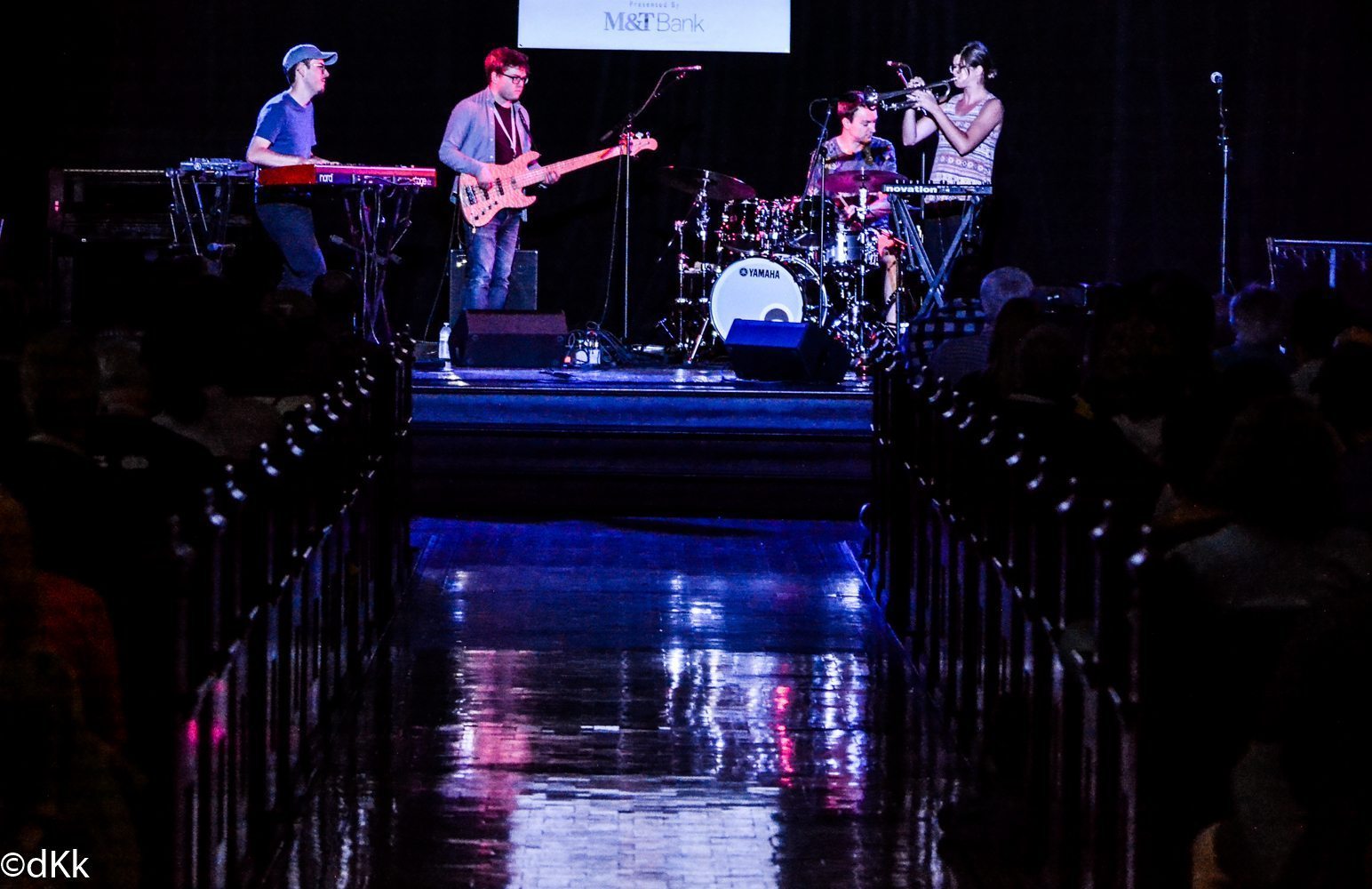
10. Dinosaur at the Christ Church
“You’ve tried the ribs, now hear the band! “—@MadeintheUKJazz
Combine an active leading groove bass style similar to Phil Lesh, a vibrant somewhat understated but no less invigorating trumpet frequently reminiscent of Miles Davis’ “electric” period, keys and electronics evoking an 80’s-esque quasi-futurism, with a drummer who can hold the entire groove in tact regardless of how “out” it goes, you get a monster of a band called Dinosaur. This British quartet could jump from fun and quirky melodies into spacey formless improvisations and back again without ever losing the underlying groove, or the audience. They mixed in Beatles-like pop melodies, wild carnival marches and hyper speed funk outs for a set that left us smiling and had us marching right back to the Christ Church for a second helping.
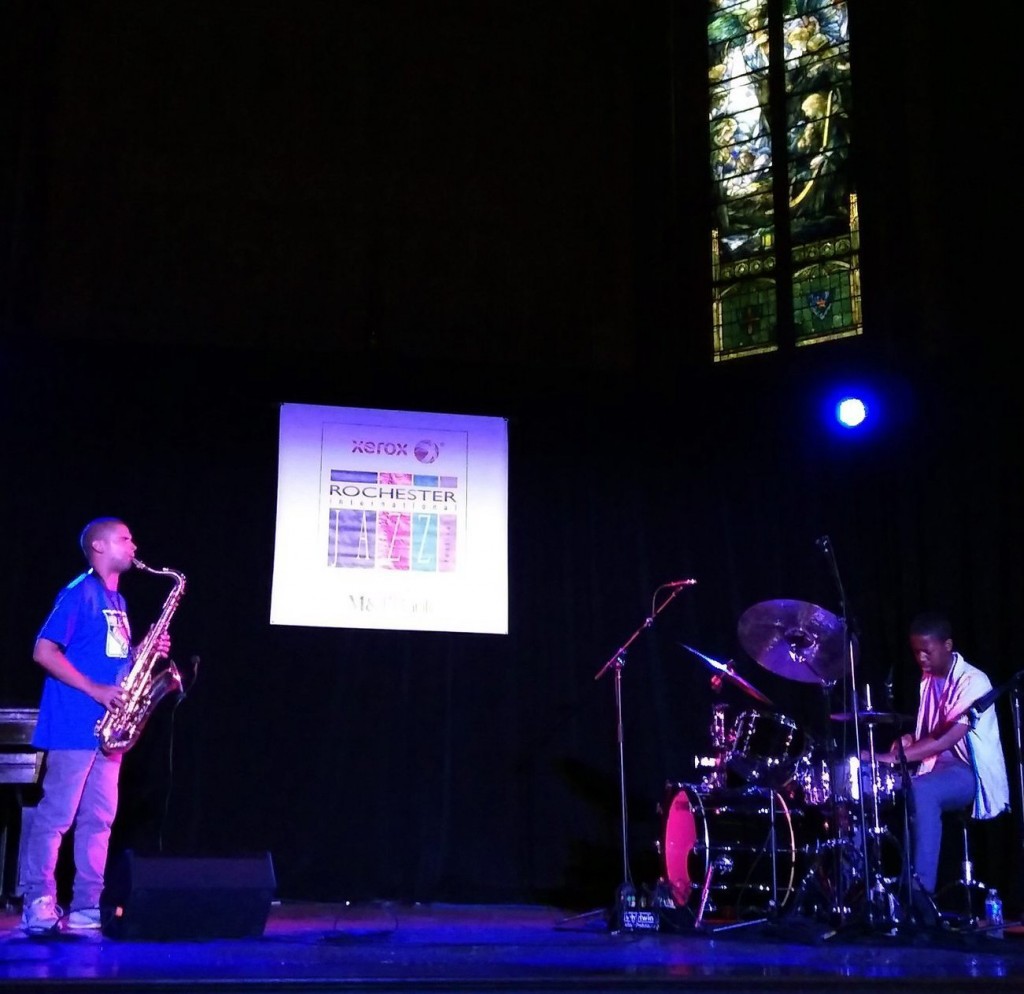
9. Binker and Moses at the Christ Church
“We hope you enjoy the journey.”—Moses Boyd
Saxophonist Binker Golding and drummer Moses Boyd together create a fluid and astounding mass of sound. With just the two of them and their instruments, no help from effects, electronics, nor loops, there was nowhere for either to hide. It also allowed for an incredible connection, the drums would cede the lead to the sax and vice versa, seamlessly passing the baton back and forth, until both were soaring to unexpected heights simultaneously. This wasn’t a showy affair, there weren’t many moments for straight-up solos, but plenty of mystifying two-part improvisations. With the limited sound possibilities it still never got monotonous. The melodies ranged from free form soundscapes to Caribbean groove to highly accessible James Brown-style funk. They played selections from their brand new album, Journey to the Mountain of Forever, and what an interesting journey it was.
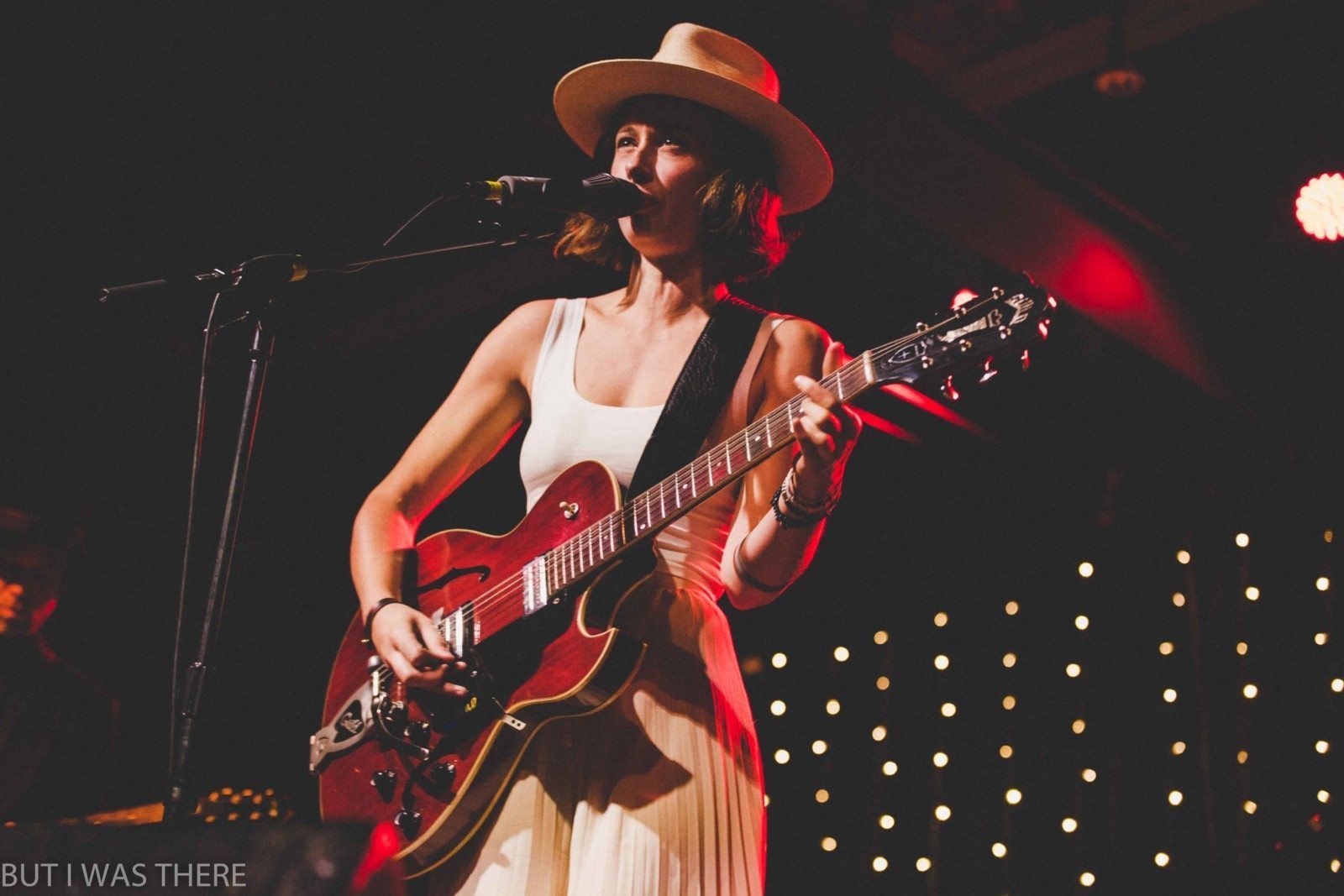
8. Lera Lynn at Squeezers Stage at Anthology
“The thing about jazz is you just keep reinventing it, so anything goes”—Lera Lynn
Folk singer-songwriter Lera Lynn might not have understood completely what she was doing at a jazz festival, but she was happy to get into the spirit. Flanked by two additional guitarists, Jody Duke and Tony Lombardo, it was a three-guitar folk assault. The three guitars worked their way around each other in different ways all night, maximizing the combination of sounds and styles, keeping the audience on it’s toes. Similarly, the guitarists provided backing vocals and harmonies in two and three parts in varying combinations, providing a much more dynamic performance then was expected from the setup. She played from across her three albums, including some of the music she wrote for HBO’s True Detective, like her haunting hit “My Least Favorite Life,” which she wrote with Roseann Cash and T Bone Burnett. Later she would close her set with Roseann’s father’s “Ring of Fire,” reworked to nearly a standstill, allowing for it to build and burst with intensity. Not used to filling up two sets of music, she filled in the gaps with some as-yet recorded material, including a first time performance of “Easy That Way,” which in a bit of a rawer state gave a glimpse to her craft and process. If the new tunes are any indication, Lynn’s name is one we expect to be hearing much more of in the future.

7. The Jerry Douglas Band at City of Rochester East Ave. & Chestnut St.
“Don’t try to dance, it’ll hurt.”—Jerry Douglas
Dobro-ist extraordinaire Jerry Douglas brought his new band, just ahead of their new album out in early August, to the crowd amassed at the big outdoor stage on Chestnut Street. The band at seven strong included fiddle, bass, guitar and even a trumpet and saxophone joining Douglas’ dobro. They played a good mix of originals like “Cave Bop,” a song about a dream involving Fred Flintstone and Charlie Parker riding together in a car pushed by Barney Rubble, “Gone to Fortingall,” about the location of Douglas’ musical web series, and “Battlestick,” a slow and slinky funk-up about fly fishing. But they also threw in some choice covers like “Hey Joe” and “Something You Got” that gave Douglas the chance to show off what was surprisingly a nice husky and bluesy voice. The highlight of the set though was a thematic and orchestral sounding instrumental which he introduced as “something wayyyyy different.” Throughout the evening Douglas was willing to cede the spotlight to his fantastic guitarist and fiddle player, showing restraint on his mastery of the dobro, but he still shined brightly when called upon.
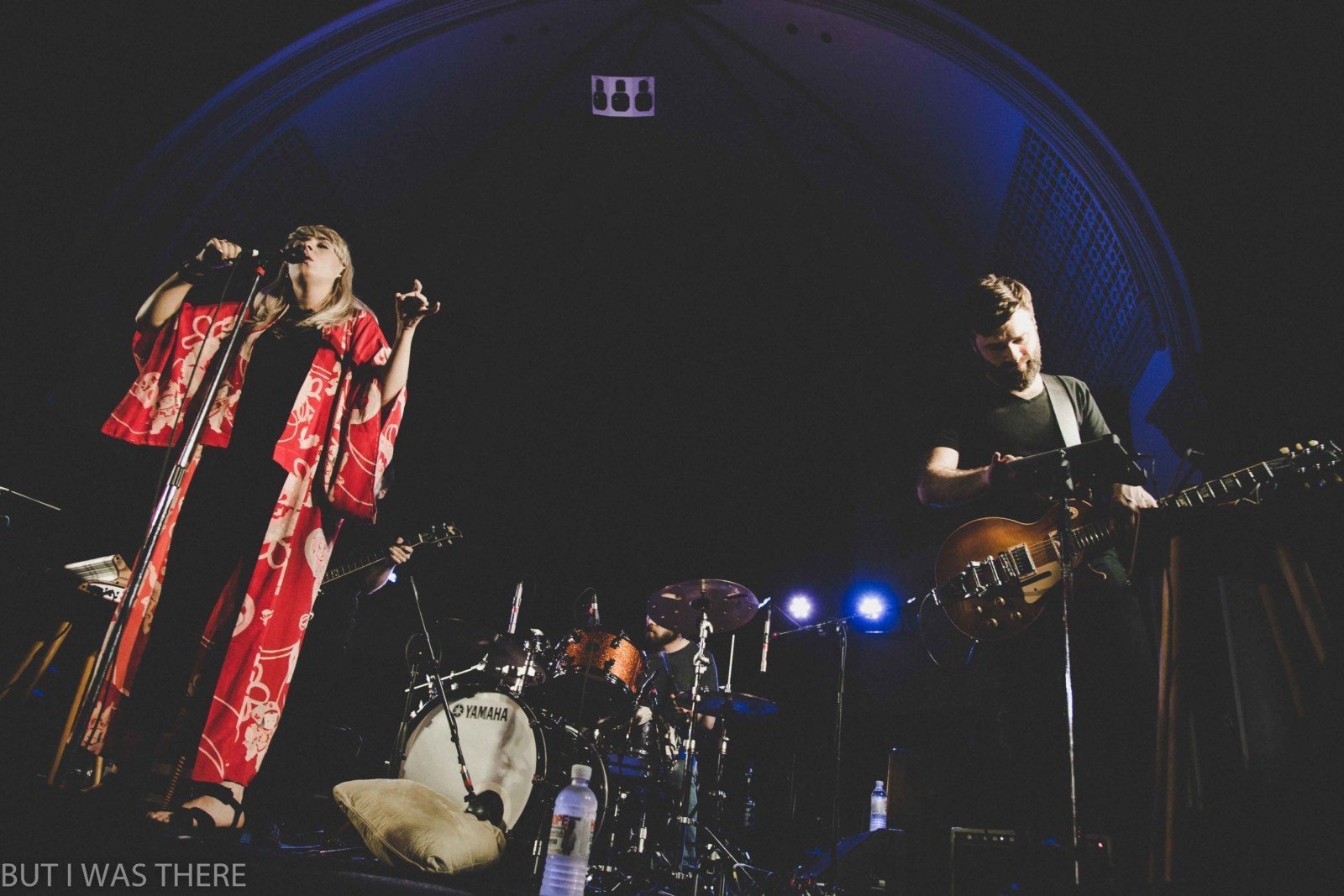
6. Yggdrasil/Eivor at Lutheran Church
“This drumstick looks like it just woke up”—Eivor
Yggdrasil was the very first set we caught at this year’s festival. They provided a very high bar for the remainder of the performances. A band from the Faroe Islands about halfway between Norway and Iceland, there was a mystical quality to the music before you even heard a single note. It is a sense that only grows stronger the longer you watch and listen. The brainchild of pianist and composer Kristian Blak, he presides over his much younger band like a shaman of the unusual ethos he has set out for the band. Eivor, the enchanting singer, could soar to the churches high ceilings in Norwegian, Faroese, English, or even nonsense syllables and noises. The music was often rooted in the past, a Faroese traditional folk song, a Shakespearean sonnet, a Native American chant, but the sounds were decidedly current, with wild guitar effects and electronic enhancements, At it’s most intense. The music mixed Radiohead and Portishead sensibilities with prog rock wildness. But there were great dynamics within the set, bringing it all the way down to a gentle folksy duet with just Kristian and Eivor.
The following night, Eivor would play with her own band in the same venue. Her incredible voice remained, but in this format, she played guitar and was joined by a drummer and keyboard player. The music was more accessible, focusing more on her singing and songs, hewing toward folk rock, on originals like “Bridges” and “The Right Shoes.” She still found space for some traditional tribal-esque Norwegian music that saw Eivor making guttural noises while banging a large drum head with a well-worn mallet. She told a great story about her first trip to Rochester 13 years ago, when she purchased the guitar she had been playing at the famous House of Guitars. She made her way back to the House of Guitars that afternoon and purchased another guitar, which she proceeded to play for the first time then and there, for a stunning cover of Leonard Cohen’s “Famous Blue Raincoat.” New and old, it all sounded great to our ears.
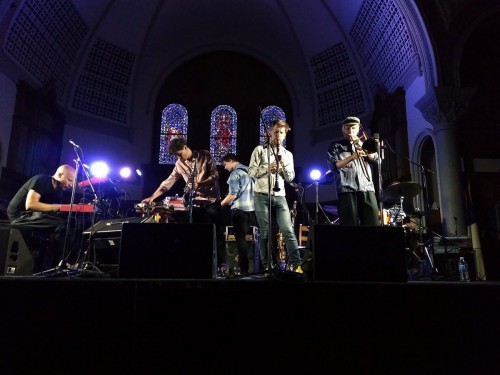
5. Klabbesbank at Lutheran Church
“You shouldn’t try to translate names I don’t think.” —Klas-Henrik “Klabbe” Horngren
The Nordic Jazz Now series provides an endless well of strange and interesting music to the XRIJF lineup on a yearly basis. The chances of being familiar with bands booked in the series are slim to none, so there is usually an element of surprise, even when you’re fully expecting it to be different and wonderful by reputation from past bookings alone. This year Swedish band Klabbesbank scratched the discovery itch the hardest for a highly satisfying set of jazzy electronic madness. A three-horn front line consisting of clarinet/sax, trombone and trumpet were backed up by Horngren leading the way on keys, a drummer and bassist. All but the brass players were also equipped with extensive electronic pedals and effects. The drummer was the most heavily equipped, and at one point the music broke down to just him throwing around samples and alien squonks and screeches, before pulsing a literal heartbeat that woke the others into joining along for a bombastic finish to the tune. The horn players were rarely syncopated like a normal horn section, they weaved three-part textures that could provide a backing soundscape or blast into the fore. For much or the set the music could be described as instrumental post-rock, mixing elements of Tortoise with the electronic bent of Battles,. Other moments channeled avant-garde jazz, with a funky flair, not unlike The Lounge Lizards. Exhilarating through and through.
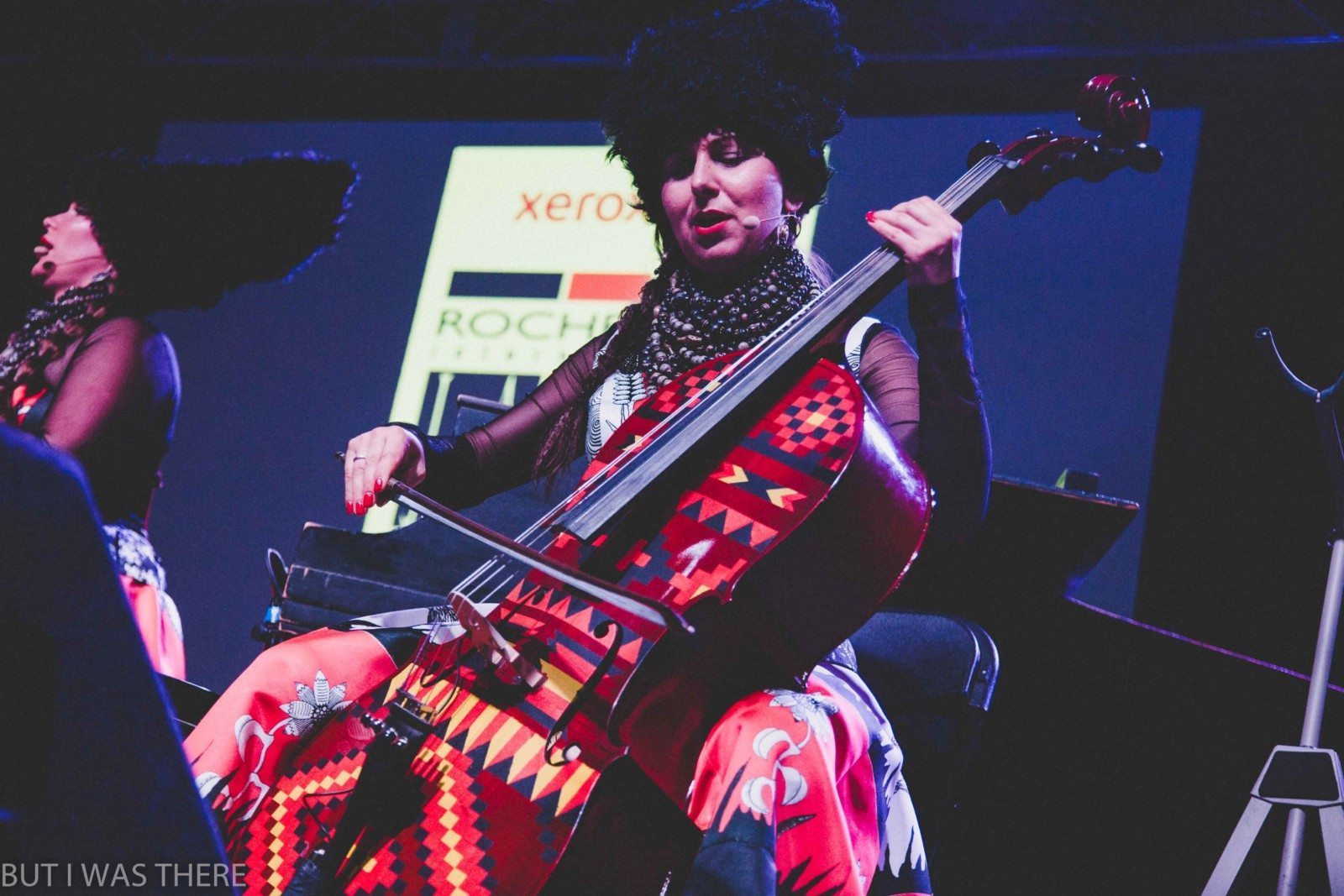
4. Dakha Brakha at the Big Tent
“Peace and love, thank you so much.”—Marko Halanevych
From embattled Ukraine, Dakha Brakha, dressed quasi-traditionally with brightly colored silk dresses and tall furry black headdresses, were a stark reminder of the connection music can make across the cultural divide. Their banter was limited and it was clear they weren’t completely comfortable addressing the crowd in English, but the music immediately reached out and grabbed the audience in a way no words could anyway. It was almost a complete departure from anything anyone in the crowd had ever heard before, yet it didn’t take more than a minute or so for every single person who made their way into the tent to be completely rapt. The quartet sat in chairs in a row across the stage, with what appeared to be minimal instrumentation, but as the set went on and they played more and more interesting instruments that seemed to appear from out of nowhere, various drums and pieces of percussion, cello, piano, accordions, ukulele, harmonica and on. But perhaps most interesting of all was their voices, three gorgeous female vocalists singing together in harmony or in hypnotic round, and a singular no less enchanting male voice that was used at one point to mimic a trumpet and another to mimic a horn in a stunning bit of improvisation. In once piece they abandoned the beauty of their voices for more of a quick chanting that for all intents and purposes was a rap, complete with a funky groove and off beat “Heys.” As they put their instruments down for the final time, the male of the group, Marko Halanevych held up the Ukrainian flag and said, “Peace and love.” That message we got loud and clear.
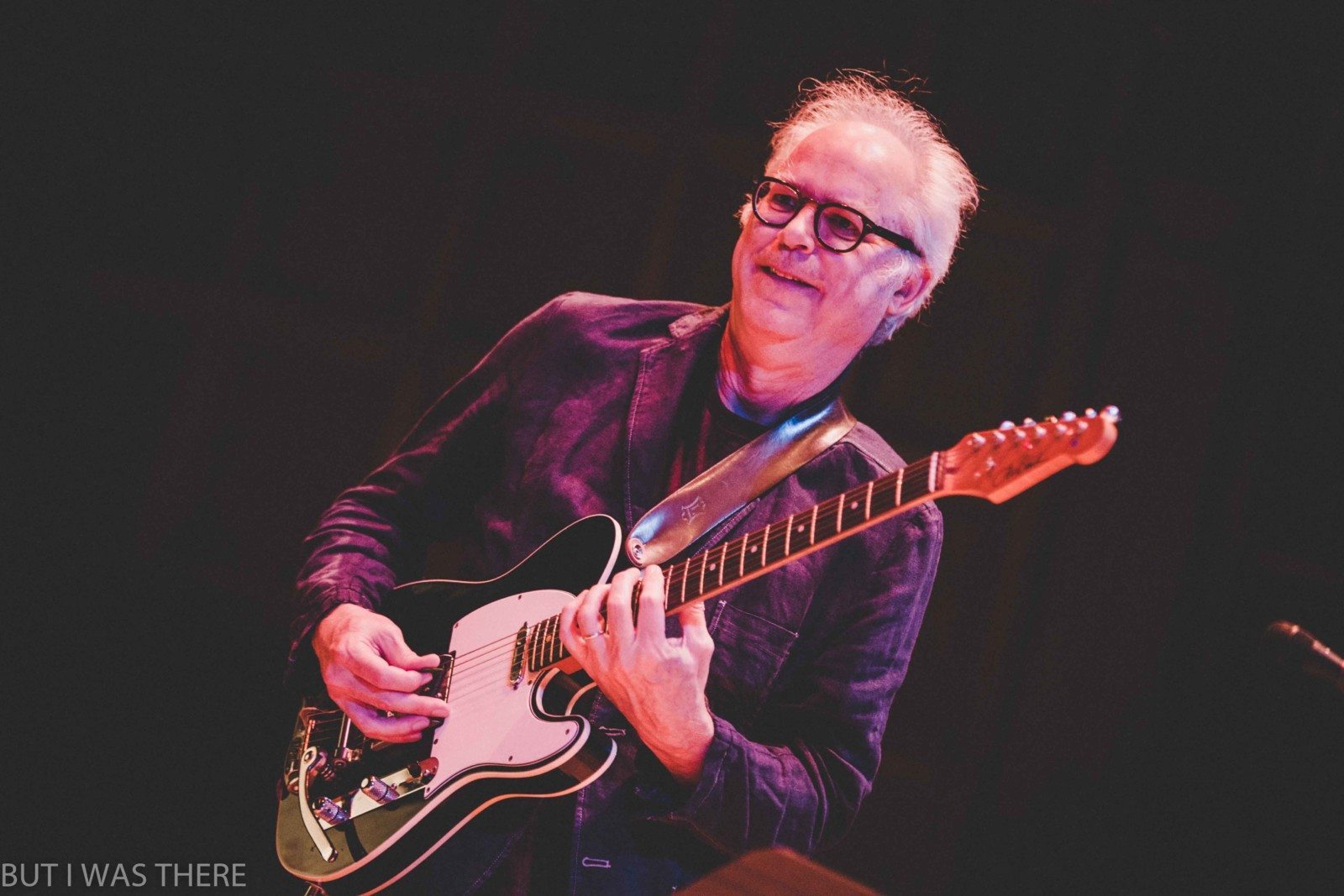
3. Bill Frisell and Thomas Morgan at Kilbourn Hall
“Thomas!”—Bill Frisell
Bill Frisell was back showcasing his guitar prowess at the festival for the sixth time. Each visit has been a different band and a different experience altogether. Frisell’s music is so entrenched in improvisation that even the early and late sets had distinguishable characteristics that set them apart. Frisell was playing in just a stripped down duo format with bassist Thomas Morgan. Morgan played a acoustic upright bass while Frisell made use of effects and looping to add some depth. Frisell and Morgan stood a few feet apart, facing each other, occasionally eyeing one another intently. They didn’t speak, rather communicating through the music. Frisell didn’t even address the crowd until just before the last number of the set, breaking the silence with a single exclamatory, “Thomas!” As one of them would run a line the other would closely follow, passing musical messages back and forth, letting the eureka moments find themselves. They were like two fish swimming in a stream, drifting along the current, sometimes fighting against it, then finding an eddy in which they could circle around for a little while, before getting pulled out by the current once again floating away. As a duo this process was greatly exposed for the audience to bear witness how these glorious bits of music emerged almost out of nowhere.In the early set, melodies took a back seat to experimentation. In the late set, the duo leaned into more recognizable melodies as they strung together a long non-stop improvisation that wound its way around tunes like “Epistrophy,” “When You Wish Upon a Star,” “Baba Drame,” “Goldfinger” and “What the World Needs Now.”
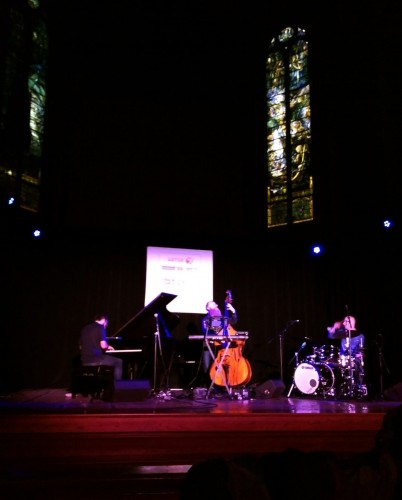
2. Neil Cowley Trio at Christ Church
“What ungodly music to play in a church!”—Neil Cowley Trio
Neil Cowley is the most heard pianist in the world, which isn’t a joke. He has played on both of Adele’s albums. But the way he and his band mates, Rex Horan on bass and Evan Jenkins on drums, pounded their way through their set they made certain they were heard loud and clear in Rochester too. The stone walls of the Christ Church threatened to crumble from the decibel levels they achieved almost entirely acoustically. The wooden pews were struggling to contain the involuntarily bouncing bodies trying to stay respectfully seated, while some in attendance couldn’t resist releasing some rock-ready whoops and howls. There have been rock bands on the docket in years past at the Rochester Jazz Festival, but no band that has rocked as hard as this trio. They played as singular a unit, ratcheting up the intensity rather than straying too far from the composition. The British wit came out both in the banter, “Are you just here to get out of the rain? That’s when we’re most popular. Very much a get out of the rain kind of band,” and also in the songs, one about a chicken who witnesses a crime, another about a spider the size of a cat that lives on their street.
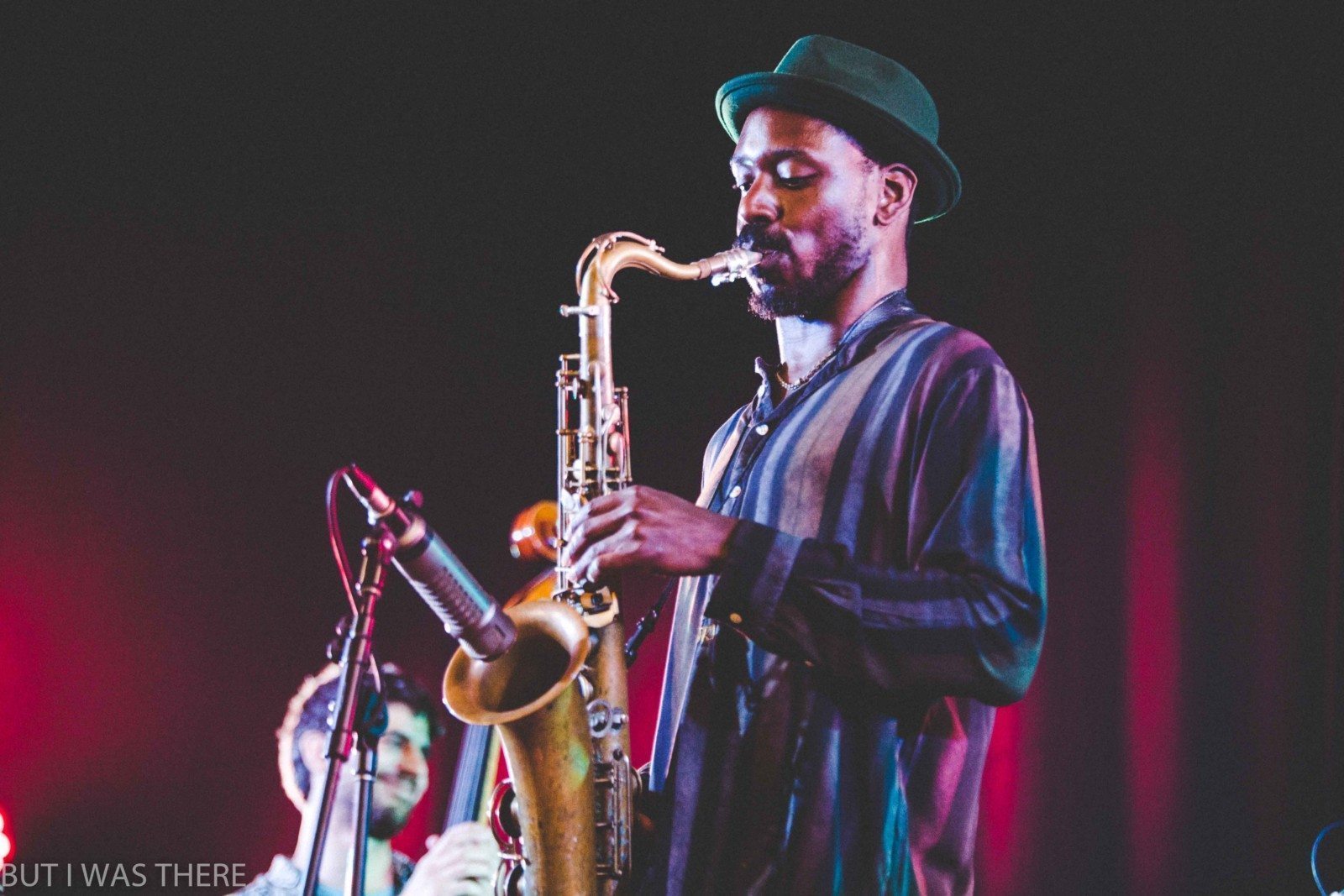
1. Shabaka and the Ancestors at Harro East Ballroom
“We need new hymns”—Siyabonga Mthembu
We saw a lot of music in churches over the course of the festival, but no set was more of a religious experience than Shabaka and the Ancestors. Shabaka Hutchings is a London-based saxophonist with Caribbean roots. For The Ancestors album he recorded in South Africa with South African musicians. The result is a modern Afro-Caribbean masterpiece, with elements of Sun Ra and John Coltrane. Two saxes, bass, drums and percussion formed a mass of music that was almost impossible to comprehend in a single moment. There were solos and leads that were easier to follow, but when a solo doesn’t end and the other members add their bits into the mix, building and building in intensity, finally adding a singer above it all, it becomes a lot to take in. Vocalist Siyabonga Mthembu would use quiet moments within and between different pieces to chant mini sermons of a sort. “In the burning of the republic of the mind, we need new people, we need new hymns.” “We need to feminize our politics.” “How can the 99 percent be controlled by the one percent?” Spiritual, political, the music serving to enhance and inflate the messages. They had one foot in the past, one foot in the present, and one foot in the future. Their issues were simultaneously the issues of the past present and future. The music was as well. The themes from tracks off their album, Wisdom of Elders, “Mzwandile,” “The Observer,” and “Nguni” found their way into the set, but it felt more free-wheeling then distinct songs. More important was the message, which like those of religious hymns, was more effectively communicated through the power of song.
We’d be remiss not to mention some of the other great music that caught our ear over the course of the festival. New York horn band Huntertones shined on their originals, but a gorgeous rendition of “God Only Knows” really stood out. The Billy Childs Quartet was as good a standard jazz outfit we witnessed, with the backing band of Dayna Stephens (sax), Ben Rhodes (bass) and especially Ari Hoenig (drums) really standing tall. John Paul White sounded great with his post-Civil Wars solo band on tunes like “Simple Song” and a surprising cover of ELO’s “Can’t Get It Out of My Head.” Dustbowl Revival, a string band with a horn section, used each of its eight pieces to their advantage, moving from swing to ska to folk to blues to funk to rock and everything in between. Jazz bands improvise. But when bands like the Eric Krasno Band or Electric Kif improvise, it’s called jamming. Krasno jammed on the bluesier side with quality covers of the Allman Brothers’ “Whipping Post” and Janis Joplin’s “Move Over,” while Miami’s Electric Kif took the fusion route covering half of Herbie Hancock’s “Thrust” before dropping a stunning version of Radiohead’s “Weird Fishes.” There were lots of great trios to be had at the festival. Phronesis returned to the festival for the third time, proving once again why they’re considered one of the best piano trios on the scene today, providing many jaw dropping moments. Austrians Mario Rom Interzone gave an impressive new look at the composition-focused trio with a trumpet replacing the usual piano. Charlie Hunter sounded great in his return to the trio format, back where it all began for him, but in a decidedly bluesier direction this time around. Ikonostasis provided heavy doses of Nordic weirdness, becoming the first Moog trio we’ve ever seen. We closed out our festival with the special 4 By Monk By 4 set, which gave us the opportunity to see four great pianists, Benny Green, George Cables, Kenny Baron and Cyrus Chestnut pay tribute to “the high priest of bebop.” We don’t need any more proof than that, music is a religion, and the Rochester Jazz Fest is a sacred holiday.
Additional Jazzfest photos by Darren Kemp
[ngg_images source=”galleries” container_ids=”763″ display_type=”photocrati-nextgen_basic_thumbnails” override_thumbnail_settings=”0″ thumbnail_width=”150″ thumbnail_height=”150″ thumbnail_crop=”1″ images_per_page=”0″ number_of_columns=”0″ ajax_pagination=”1″ show_all_in_lightbox=”0″ use_imagebrowser_effect=”0″ show_slideshow_link=”1″ slideshow_link_text=”[Show as slideshow]” ngg_triggers_display=”never” ngg_proofing_display=”0″ order_by=”pid” order_direction=”ASC” returns=”included” maximum_entity_count=”500″]
Additional Jazzfest photos by Brian Ferguson
[FinalTilesGallery id=’971′]


Comments are closed.